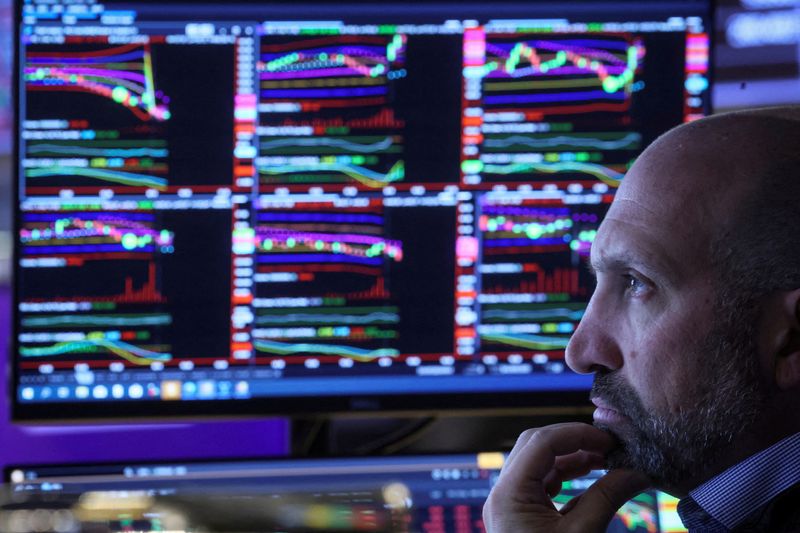By Lewis Krauskopf
NEW YORK (Reuters) - Despite a crushing selloff that pushed U.S. stocks into a bear market, investors see few signs suggesting equities have hit bottom, as persistent worries over surging inflation and an aggressive Federal Reserve continue to pressure asset prices.
The market’s losses have been steep. The 21.3% year-to-date decline in the S&P 500 as of Monday wiped out some $8.7 trillion in market value this year, according to S&P Dow Jones Indices.
Meanwhile, the highest inflation rise in four decades has investors pricing in a once-unthinkable 75 basis-point rate increase at the Fed’s monetary policy meeting on Wednesday, and worries are growing that the central bank won’t be able to tame consumer prices without tipping the economy into a recession.
Some strategists, however, are not convinced that all the factors are in place to mark the end of the declines.
“This is not necessarily what a bottom looks like," said Mark Hackett, chief of investment research at Nationwide. "It is perhaps what a bottoming process looks like.”
GRAPHIC: S&P 500 bear markets since 1946 (https://graphics.reuters.com/USA-STOCKS/BOTTOM/egpbkgkkxvq/chart.png)
The S&P 500 on Tuesday ended down 22.1% from its Jan 3 record peak. The average decline for bear markets since 1946 has been 32.7%, according to investment research firm CFRA, which may suggest the current slide may have more room to run.
Similarly, the average bear market has lasted 389 calendar days from the peak to the bottom, more than twice as long as the current bear slide.
Hackett and other market participants are also watching a number of technical signs indicating that selling in stocks may have reached a crescendo.
One of the more famous indicators is the Cboe Volatility Index, or VIX, which is known as “Wall Street’s fear gauge” and measures the expectation of stock-market volatility as expressed by options prices.
Since 1990, the volatility index has reached an average level of 37 at market bottoms, and spiked to 85 during the market’s coronavirus-fueled swoon of March 2020. By contrast, the VIX rose to 35.05 during Monday’s selloff: above its long-term median of about 18, but still below peak levels in other bear markets.
“It feels like investors are less panicked and more resigned to the fact that the next 6-12 months is going to be a slog (and elevated volatility is here to stay longer),” wrote Chris Murphy, co-head of derivative strategy at Susquehanna International Group, commenting on VIX contracts going out into the next year.
GRAPHIC: VIX and bear markets (https://fingfx.thomsonreuters.com/gfx/mkt/zjvqklkqxvx/Pasted%20image%201655235253967.png)
Still, volume on puts, which investors use to protect their portfolios from stock declines, hit 2.03 million contracts on Monday, the highest level since Fed 28, 2020, according to Trade Alert data.
Some also watch indicators on investor sentiment, with the hopes of potentially swooping into the markets when pessimism is high and selling is becoming exhausted.
Many such indicators show sentiment has soured. The latest weekly survey of the American Association of Individual Investors, for example, found bearish sentiment at 46.9% – topping its long term average of 30.5% but still below levels from earlier this year.
Those readings came before the higher-than-expected inflation reading on Friday that sent stocks tumbling and could sour investor sentiment further.
GRAPHIC: Bearish investor sentiment (https://graphics.reuters.com/USA-STOCKS/WEEKAHEAD/zdvxoeoonpx/chart.png)
“Investor sentiment has been negative for a while now and that is a sign telling us we might be getting there as a bottom but we are not quite there yet,” said Angelo Kourkafas, an investment strategist at Edward Jones.
Technical indicators aside, Kourkafas said it will be difficult for the market to fully bottom until investors are confident inflation has ebbed, allowing the Fed to ease back on its monetary tightening.
Others, however, are urging investors to focus on the long-term. Keith Lerner, co-chief investment officer at Truist Advisory Services, notes that less than 5% of S&P 500 stocks are trading above their 50-day moving average.
That's only happened nine times since 1990, and the S&P 500 was up in every single case a year later, with an average gain of 23%.
"Given the market is already pricing in a high probability of recession, that stocks are very oversold on several metrics, that valuations (while not cheap) have been reset, and sentiment is depressed, we would not reduce equities," he wrote in a Tuesday report.
